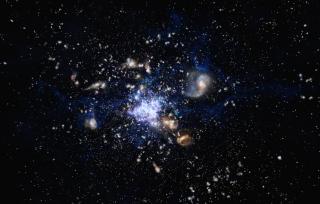Bibcode
Pérez-Martínez, J. M.; Dannerbauer, H.; Kodama, T.; Koyama, Y.; Shimakawa, R.; Suzuki, T. L.; Calvi, R.; Chen, Z.; Daikuhara, K.; Hatch, N. A.; Laza-Ramos, A.; Sobral, D.; Stott, J. P.; Tanaka, I.
Bibliographical reference
Monthly Notices of the Royal Astronomical Society
Advertised on:
1
2023
Citations
43
Refereed citations
37
Description
We use multi-object near-infrared spectroscopy with VLT/KMOS to investigate the role of the environment in the evolution of the ionized gas properties of narrow-band-selected H α emitters (HAEs) in the Spiderweb protocluster at z = 2.16. Based on rest-frame optical emission lines, H α and [N II]λ6584, we confirm the cluster membership of 39 of our targets (i.e. 93 per cent success rate), and measure their star formation rates (SFR), gas-phase oxygen abundances, and effective radius. We parametrize the environment where our targets reside using local and global density indicators based on previous samples of spectroscopic and narrow-band cluster members. We find that star-forming galaxies embedded in the Spiderweb protocluster display SFRs compatible with those of the main sequence and morphologies comparable to those of late-type galaxies at z = 2.2 in the field. We also report a mild gas-phase metallicity enhancement (0.06 ± 0.03 dex) at intermediate stellar masses. Furthermore, we identify two UVJ-selected quiescent galaxies with residual H α-based star formation and find signs of extreme dust obscuration in a small sample of starbursty submillimetre galaxies based on their FIR and H α emission. Interestingly, the spatial distribution of these objects differs from the rest of HAEs, avoiding the protocluster core. Finally, we explore the gas fraction-gas metallicity diagram for seven galaxies with molecular gas masses measured by ATCA using CO(1-0). In the context of the gas-regulator model, our objects are consistent with relatively low mass-loading factors, suggesting lower outflow activity than field samples at the cosmic noon and thus, hinting at the onset of environmental effects in this massive protocluster.
Related projects

Molecular Gas and Dust in Galaxies Across Cosmic Time
Two of the most fundamental questions in astrophysics are the conversion of molecular gas into stars and how this physical process is a function of environments on all scales, ranging from planetary systems, stellar clusters, galaxies to galaxy clusters. The main goal of this internal project is to get insight into the formation and evolution of
Helmut
Dannerbauer